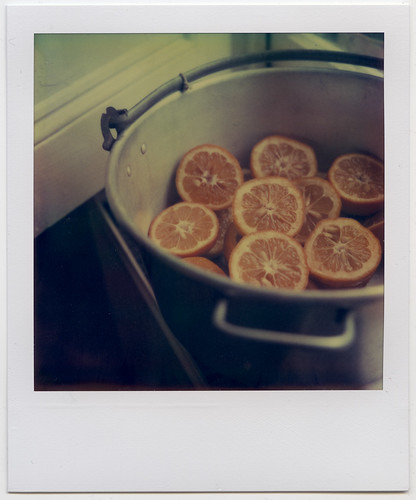 |
| Seville Oranges ii, a photo by cyan blue on Flickr |
I'm not quite sure that I remember the first time I tasted vin d'orange, but one thing I do know is that it must have been related, in some way, to Chez Panisse.
Current and former employees of the restaurant alike are obsessed with it. Bottle corkers have been purchased by the dozen, it's poured liberally at practically every dinner party and celebration, and I think a Seville orange tree might have been planted at the Edible Schoolyard expressly for the promise of future vintages of vin d'orange (ok, ok--marmalade too).
Vin d'orange is a Provençal apéritif traditionally made with lumpy, bitter, seedy Seville oranges. I grew up thinking the only use for these sour oranges was as a foil for fried fish, as is done in Iran, but when I began cooking I saw them appear from time to time in the sweet kitchen. After a little snooping around, I learned the history of the Seville orange as the original citrus used in British marmalades, and the last time I was in Iran, I spent a couple of days picking their nauseatingly fragrant blossoms with my aunt and grandmother in our family orchards so we could distill some orange flower water. But definitely, the easiest and most elegant use for these fruits is a batch of vin d'orange.
Last week, Martin browbeat me into buying a case of Sevilles from him, and since I don't have the time to make marmalade, Suzanne came over and we made vin d'orange. Maybe I'll serve it at the next New Year's Eve at Tartine?
Vin d'orange
Adapted from a recipe from Tracy Bates and Suzanne Drexhage
Using rosé will yield a really special vin d'orange, but since I try to do this on the cheap, I don't usually bother spending the money. Jug wine is totally fine for this, since you'll be adding so much sugar, vodka, and of course, oranges. At Eccolo, I just used our James Arthur Field cooking wine.
5 liters crisp, bright white wine such as sauvignon blanc. You can use rosé if you're a high roller.
1 liter vodka
11/2 pounds sugar
1 vanilla bean, split
12 Seville oranges
1 orange
1 lemon
Rinse all of the citrus. Cut all of the fruit into chunks. I usually cut the oranges in half, then quarter the halves. This isn't so much about juice as it is about exposed surface area of the fruit. In fact, juice will make the final product cloudy.
Place everything in a big bucket, give it a stir to dissolve the sugar, cover, and put in a cool space for 30-42 days. I believe that traditionally, it's left for 40 nights, but each batch is different, so it's important to taste it from time to time to see how it's progressing.
I try to fit it all in the back of the fridge, but if that's not possible for you, a cool closet or basement should be fine. Check on the vin every few days, adjusting the sugar if necessary, and plucking out a few pieces of orange if you notice it's getting too bitter too quickly.
After 30-42 days, remove the solids and strain through double layered cheesecloth into bottles, being careful not to pour in the sediment from the bottom of the bucket. If your vin is especially cloudy, and you're feeling patient, try straining it through a coffee filter.
We usually just collect old wine bottles and remove the labels, then use a corker to cork them back up. You could also just use a mason jar!
If you used the corker, you can store the vin d'orange at room temperature. If it's in a mason jar or other unsealed bottle, then keep it in the fridge for up to a year. The reason why I think it's worth going to the extra trouble to cork it is this: as time passes, the flavors of the wine will mellow and come together. Vin d'orange gets better after a few months, and if you can wait, it's really good after a year. I had a friend who misplaced a few bottles and found them four years later--that was the best batch we'd ever tasted!
Serve chilled, poured over a couple ice cubes, with a twist of orange--the perfect summer aperitif.
Resources
This really cool flow chart of citrus ancestry
Bottle corkers, corks, etc.
The Oak Barrel
Where to find Seville oranges in the Bay Area:
Monterey Market
Bi-Rite Market
Berkeley Bowl
DeSantis Farm, which goes to Alemany Farmers Market and the Heart of the City Farmers Market
Where to find Seville oranges online:
Melissa's
An Alternative:
A recipe for vin d'orange made with sweet oranges, in case you can't get your hands on any Sevilles.

Hi Samin,
ReplyDeleteWhat kind of container do you store it in during the 45 days?
Thanks,
Anna
Hi Anna!
DeleteI keep it in a cambro from the restaurant supply store, but a big stock pot or a bowl with plastic wrap would work, too!